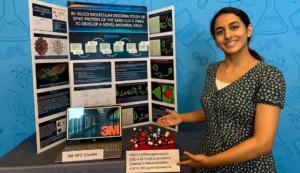How an Indianapolis Nonprofit Transformed American STEM Education

Almost half of American public secondary schools use an active project- and problem-based approach to science, technology, engineering and math (STEM) education that shows learners how knowledge and skills may be applied in everyday life.
The popular curriculum doesn’t come from one of the big publishers. It’s from an Indianapolis nonprofit with a unique name: Project Lead The Way, now widely known simply as PLTW.
Think of PLTW as STEM-as-a-service. Schools subscribe to PLTW and get coursework delivered through a learning management system (LMS) (on Canvas since 2013), high-quality professional development, and access to 24/7 technical support.
Launched in 1997 in upstate New York, the nonprofit was serving about 2,000 schools when an Indiana school superintendent, Dr. Vince Bertram, took over and moved the organization to Indianapolis with local and regional support and the backing of Mayor Bart Peterson and Governor Mitch Daniels. It helped that Indiana was the largest PLTW state with about 300 school partners.
What was a high school engineering program has become three PreK-12 pathways in computer science, engineering, and biomedical science. Under Bertram’s leadership, PLTW has grown from serving around 300,000 students in 2011 to about five million students–and the organization is growing by over a million students per year with a sustainable business model. (Listen to this podcast with Vince Bertram.)
Corporate and philanthropic partners have been important to PLTW success. The Kern Family Foundation began supporting PLTW in 2004 and to date has invested almost $34 million.
PLTW Programs
The flagship high school program, PLTW Engineering, empowers students to step into the role of an engineer and adopt a problem-solving mindset.
PLTW Biomedical Science is a high school program that allows students to work with the same tools used by health professionals to find solutions to biomedical problems. Courses include biomedical principles, body systems, medical systems, and biomedical innovations.
PLTW Computer Science began in 2014 and allows students to design solutions while they learn computational thinking as well as coding.
PLTW Launch is a PreK-5 program launched four years ago. Bertram said it was important to move into elementary grades because students begin to form their academic identity by the second or third grade–and having a positive view of themselves as designers and problem solvers (as well as readers and writers) keeps high school options open. Bertram believes an integrated project-based approach to math and science in the elementary grades can effectively address persistent gender and racial gaps in secondary and postsecondary enrollment in STEM programs.
PLTW Gateway is grade 6-8 program with 10 units designed as nine-week modules that fit into any middle school schedule. The hands-on units, such as Design and Modeling, Automation and Robotics, and App Creators, promote engagement, collaboration and comprehension.
In 2016, Michelle Gough joined as Senior Vice President and Chief Legal and Assessment Officer and began reviewing curriculum, practices and claims. With the support of an expert advisory board, the PLTW team built a new set of interim and end-of-course assessments, which were piloted this year. Each assessment item was validated by industry and higher education partners and PLTW teachers. Assessments include rich scenarios and simulations comprised of complex, multidimensional ethical, technical, and communication challenges. Some end of course exams make students eligible for college credit or hiring preference.
About a do-it-yourself project-based approach, Bertram said, “It’s incredibly difficult, that’s why we back up our programs with readiness training and extensive professional development, and have a strong support team—all at a low cost.” He added that the PLTW programs give teachers flexibility.
PLTW has become America’s number one provider of professional development of STEM teachers, training roughly 12,000 teachers annually through its core training programs. Increasingly, major corporations such as Toyota, Chevron, John Deere, Verizon, Lockheed Martin, and many others are partnering with PLTW to address their future STEM workforce needs.
Leadership Backstory
Vince Bertram grew up poor in a little town in east Indiana. Neither of his parents finished high school, so education was not highly valued at home. His parents split up when he was in middle school. It was teachers who inspired his educational success and encouraged him to study education at Ball State.
After teaching, Bertram served as a suburban, and then urban high school principal in Indianapolis.
In 2007, Bertram was appointed superintendent of the Evansville Vanderburgh School Corporation, which is the third largest district in the state. His district made effective use of PLTW curriculum. He realized that with effective leadership, he could impact thousands of students.
In 2011, the PLTW board asked Bertram to take on the leadership of the academically sound but financially strapped curriculum provider. A board member recalled that “Vince brought a missionary-like zeal and belief in PLTW. He had seen it transform children’s lives in a large, urban high school and across his district.”
He realized the timing was good with growing interest in STEM fields. He set out to reduce barriers to school participation while building a scalable business model. He made good use of federal grants, philanthropic support of new program development and regional scaling efforts, and expanded corporate partnerships. He earned an MBA from Georgetown University in his spare time.
Bertram has proven to be a very capable business leader, but it’s his commitment to equity that has been an inspiration to his staff and supporters.
“Our primary focus is creating experiences that don’t allow for inequities,” said Bertram and pointing to the push into elementary and middle grades as an example.
While other curriculum providers might focus on easy wins, Bertram wants to be places where it’s hard. “We don’t go to easy places, we go to impoverished places, we take on any challenge,” said Bertram.
In his book Dream Differently: Candid Advice for America’s Students, Bertram offers insight for students, such as, “You need a plan before making a big investment in college.” Noting the weight of the $1.6 trillion in American student loan debt, he encourages young people to consider high wage, high demand jobs available with certificates.
Kern Family Foundation President and PLTW Board Member Jim Rahn said, “Vince Bertram is among America’s most visionary and effective educational leaders.”
“It’s not a job for Bertram, it’s a mission,” explained Rahn, “He knows that PLTW transforms the lives and impacts the life trajectory of students and teachers.”
For more, see:
- All About STEM High Schools
- Smart List | 40 STEM Networks and Maker Resources
- STEM Projects in Active Learning Spaces at Samueli Academy
This post was originally published on Forbes.







0 Comments
Leave a Comment
Your email address will not be published. All fields are required.